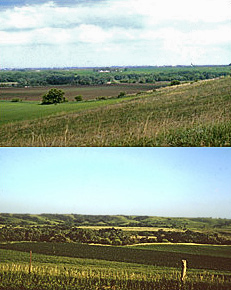43°28′N 96°35′W / 43.47°N 96.58°W
Blood Run Site | |
 | |
| Nearest city | Sioux Falls, South Dakota, Granite, Iowa, and Canton, South Dakota |
|---|---|
| Built | 1300 (possibly built over three millennia) though the site was inhabited regularly for 8500 years in other than mound era dwelling. |
| Architect | Ho-Chunk, Ioway, Otoe, Missouri |
| Architectural style | Civic, Ceremonial, Effigy, and Burial Mounds. Including a 1.25 miles (2.01 km) long snake mound destroyed for railroad fill (1930s). |
| NRHP reference No. | 70000246 |
| Significant dates | |
| Added to NRHP | August 29, 1970[1] |
| Designated NHL | August 29, 1970[2] |
The Blood Run Site is an archaeological site on the border of the US states of Iowa and South Dakota. The site was essentially populated for 8,500 years, within which earthworks structures were built by the Oneota Culture and occupied by descendant tribes such as the Ioway, Otoe, Missouri, and shared with Quapaw and later Kansa, Osage, and Omaha (who were both Omaha and Ponca at the time) people. The site was so named on account of the iron-stained soil.[3]
- ^ "National Register Information System". National Register of Historic Places. National Park Service. January 23, 2007.
- ^ "Blood Run Site". National Historic Landmark summary listing. National Park Service. Archived from the original on June 6, 2011. Retrieved October 3, 2007.
- ^ "Tidbits". Ludington Daily News. August 4, 2001. p. 33. Retrieved October 15, 2015.